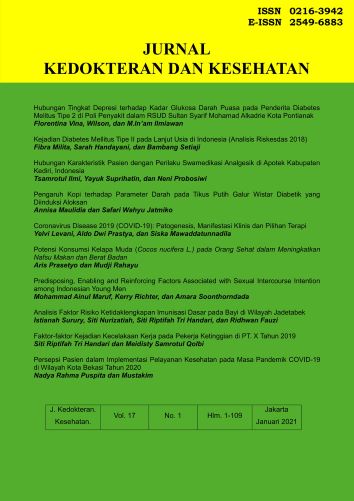Predisposing, Enabling and Reinforcing Factors Associated with Sexual Intercourse Intention among Indonesian Young Men
DOI:
https://doi.org/10.24853/jkk.17.1.66-76Keywords:
sexuality, young men, IndonesiaAbstract
Premarital sex among young men is more acceptable than young women. The Indonesian Demographic and Health Survey data consistently shows that the percentage of sexual experiences in young men is higher than that of young women and is increasing every year (6% versus 1% in 2007 and 8% versus less than 1% in 2012). This study aims to investigate which factors influence sexual intercourse intention among young men in Indonesia. This study obtained data from the 2012 Indonesian Demographic and Health Survey, especially the Adolescent Reproductive Health component with a total number of respondents of 9,109 young unmarried men. Data were analyzed descriptively and inferentially using the chi-square test and the Mann Whitney test. There are 21.1% of young men who intend to have premarital sex. Predisposing factors such as knowledge and attitudes on reproductive health, enabling factors such as dating behavior, as well as reinforcing factors such as sources of reproductive health information (peers, siblings/relatives, health service providers, religious leaders and the media) were found to be associated with the intention to have sexual intercourse. These findings indicated the need to strengthen the role of peer educators and health service providers as well as the involvement of religious leaders, and the media in adolescent reproductive health programs.References
Berliana SM, Utami ED, Efendi F, Kurniati A. Premarital Sex Initiation and the Time Interval to First Marriage Among Indonesians. Bulletin of Indonesia Economic Studies. 2018;54(2):215–32.
Oktriyanto, Alfiasari. Dating and Premarital Sexual Inisiation on Adolescence in Indonesia. Jurnal Kesehatan Masyarakat. 2019;15(1):98–108.
Badan Pusat Statistik (BPS) Indonesia NP and FP, Health (BKKBN), Ministry of Health (Kemenkes) II. Indonesia Demographic and Health Survey 2012: Special Report on Adolescent Reproductive Health. 2013.
GS G. Culture and Identitiy in a Muslim Society. Oxford University Press. 2007;
Dialmy A. Sexuality and Islam. The European Journal of Contraception Reproductive Health Care. 2010;15(3):160–8.
Kabatova K. Overcoming a Taboo : Normalizing Sexuality Education in Kazakhstan [Internet]. Vol. 200, Central Asia Program Fellows Paper. 2018. Tersedia pada: ttp://centralasiaprogram.org/wp-content/uploads/2018/01/Kabatova-CAP-Fellows-Paper-January-2018.pdf.
Alalade D. Holy Bible Holy Koran: Almighty and All Powerfull - Side by Side. North Carolina: Lulu Press; 2011.
UNICEF Indonesia. Responding to HIV and AIDS. Issue Briefs [Internet]. 2012;(October 2012):1–4. Tersedia pada: https://www.fast-trackcities.org/sites/default/files/UNICEF Indonesia- Responding to HIV and AIDS.pdf
Xiayun Z, Chaohua L, Ersheng G, Yan C, Hongfeng N, Zabun LS. Gender Differences in Adolescent Premarital Sexual Permissiveness in Three Asian Cities: Effects of Gender-Role Attitudes. Journal of Adolescence Health. 2012;50(3):S18–25.
Lyons HA, Manning WD, Longmore MA, Giordano PC. Young Adult Casual Sexual Behavior: Life Course Specific Motivations and Consequences. Sociological Perspective. 2014;57(1):79–101.
Owen JJ, Rhoades GK, Stanley SM, Fincham FD. “Hooking Up” among college students: demographic and psychosocial correlates. Archive of Sexual Behavior. 2010;39(3):653–63.
Situmorang A. Adolescent Reproductive Health in Indonesia. STARH Program. 2003;
Widyastari DA, Shaluhiyah Z, Widjanarko B. Urinating after Sexual Intercourse Prevents Pregnancy: Adolescents’ Misconceptions of Reproductive Health Knowledge Buang air kecil Pascahubungan Seks Mencegah Kehamilan: Kekeliruan Pemahaman Remaja Yang Menjadi Masalah Kesehatan Reproduksi. Jurnal Kesehatan Reproduksi. 2011;1(2):102–12.
Jarrett SB, Udell W, Sutherland S, McFarland W, Scott M, Skyers N. Age at sexual initiation and sexual and health risk behaviors among Jamaican adolescents and young adults. AIDS and Behavior. 2018;22(Suppl 1):57–64.
Abdullah F, Draman S, Abd. Aziz KH, Zainuddin NA, Muhammad NA. Predicting sexual intention to engage in premarital sex among late adolescent in Kuantan Government Secondary Schools: An application of theory of planned behaviour. International Medical Journal Malaysia. 2020;19(1):109–16.
Peҫi B. Peer Influence and Adolescent Sexual Behavior Trajectories: Links to Sexual Initation. European Journal of Multidisciplinary Studies. 2017;4(3):96–105.
Ybarra ML, Strasburger VC, Mitchell KJ. Sexual media exposure, sexual behavior, and sexual violence victimization in adolescence. Clinical Pediatics. 2014;54(13):1239–47.
Peter J, Valkenburg PM. The influence of sexually explicit Internet material on sexual risk behavior: a comparison of adolescents and adults. Journal of Health Communication. 2011;16(7):750–65.
Richards-Shubik S. Peer effects in sexual initiation: Separating demand and supply mechanisms. Quantitative Economics. 2015;6(3):663–702.
Bongardt D van de, Graaf H de, Reitz E, Dekovic M. Parents as moderators of longitudinal associations between sexual peer norms and Dutch adolescents’ sexual initiation and itention. Journal of Adolescence Health. 2014;55(3):388–93.
Baams L, Overbeek G, Bongardt D van de, Reitz E. Adolescents’ and their friends’ sexual behavior and intention: Selection effects of personality dimensions. Journal of Research in Personality. 2014;54:2–12.
Cabral P. Early parent-child sex communication, dating behaviors, and decision-making processes in subsequent sex initiation across Latina/o adolescents’ generational status [Internet]. University of California, Merced; 2018. Tersedia pada: http://worldheritage.ucmerced.edu/lab
Badan Pusat Statistics Indonesia, National Population and Family Planning, Ministry of Health II. Indonesia demographic and health survey 2012: Adolescent reproductive health [Internet]. Badan Pusat Statistics Indonesia, National Population and Family Planning Board, Ministry of Health, ICF International. Jakarta; 2013. Tersedia pada: https://dhsprogram.com/pubs/pdf/FR281/FR281.pdf
Raingruber B. Contemporary Health Promotion in Nursing Practice. In: Health Promotion Theories. United States: Brulington, Mass: Jones & Barlett Learning, c2014; 2014.
Simms DC, Byers ES. Heterosexual daters’ sexual initiation behaviors: use of the theory of planned behavior. Archive of Sex Behavior. 2013;42(1):105–16.
Harding C. The influence of the “Decadent West”: Discourses of the Mass Media on Youth Sexuality in Indonesia. Intersect Gend Sex Asia Pacific [Internet]. 2008;(18). Tersedia pada: http://intersections.anu.edu.au/issue18/harding.htm
Chairilsyah D. Sex Education in the Context of Indonesian Early Childhood. International Journal Education Best Practice. 2019;3(2):41.
Kathleen A. Ethier PD, Christopher R. Harper PD, Elizabeth Hoo, Ph.D. MPH, Patricia J. Dittus PD. The Longitudinal Impact of Perceptions of Parental Monitoring on Adolescent Initiation of Sexual Activity. Journal Adolescence Healt.. 2016;59(5):570–6.
Amie M. Ashcraft, Ph.D. MPH, Pamela J. Murray, MD. MPH. Talking to Parents About Adolescent Sexuality. Pediatric Clinic of North America. 2017;64(2):305–20.
Downloads
Published
Issue
Section
License
The copyright of the article fully belongs to the Jurnal Kedokteran dan Kesehatan and publishing rights belong entirely to Faculty of Public Health, Universitas Muhammadiyah Jakarta
Jurnal Kedokteran dan Kesehatan is licensed under a Creative Commons Attribution-NonCommercial 4.0 International License.

